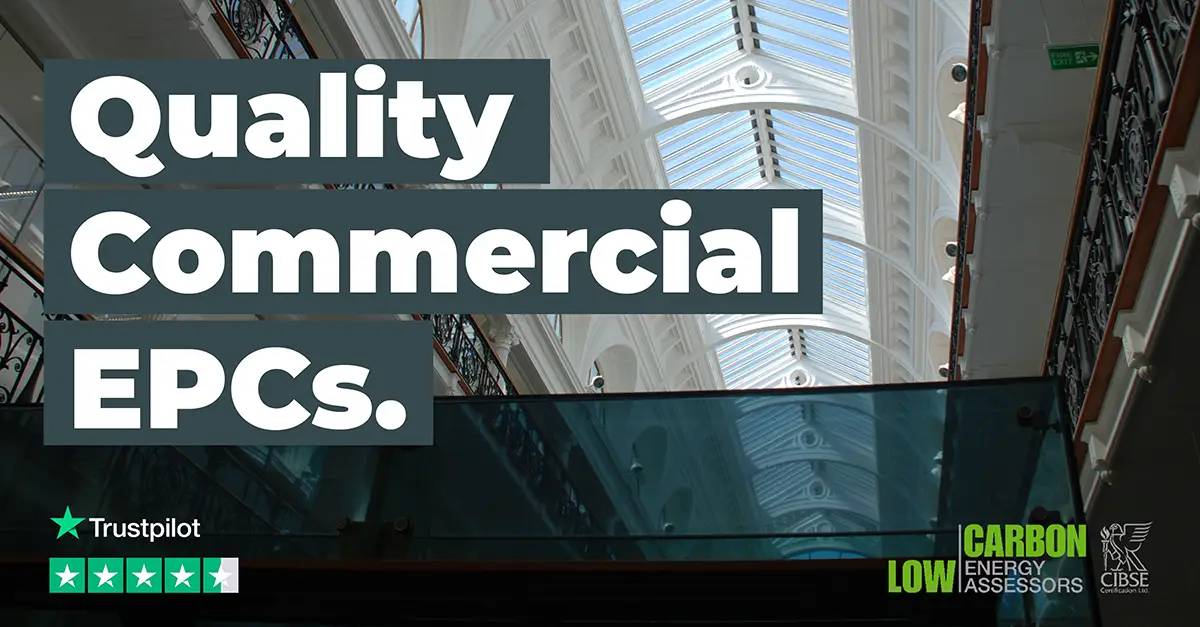Switching to HVO Fuel in Oil Boilers
Many commercial buildings, especially rural or off-grid locations, still rely on oil-powered systems to provide the necessary heating needs of the building. Where these oil boilers may have previously been suitable, tightening of the UK’s Minimum Energy Efficiency Standards (MEES) may mean that they will no longer be legally acceptable. Learn more about MEES and Energy Performance Certificates here.
This blog will explain how replacing traditional heating oil with HVO (Hydrotreated Vegetable Oil), can quickly get a commercial G rated property up to a C, or even B rating in a cost-effective, undisruptive way.

Why Heating Oil Leads to Poor EPC Ratings
Commercial EPC (Energy Performance Certificate) ratings are calculated by estimating the annual CO₂ emissions produced by the building. Traditional heating oil, also known as kerosene, is very carbon intensive, producing around 0.3 kg of CO₂ per kWh – roughly 50% more than natural gas.
While an EPC rating does consider other factors such as insulation, glazing, and overall energy efficiency, an oil boiler is almost always a clear sign that a property will score a G or F. The high-carbon nature of the fuel still dominates the calculation, meaning even the most modern and well-maintained systems cannot achieve a high EPC rating.
Switching to HVO fuel offers a simple, cheaper alternative to significantly reduce carbon emissions and therefore improve EPC ratings.
Note: Domestic EPCs are dictated more by cost and therefore they are not necessarily improved by this switch.
What is HVO Fuel & How Can it Help?
HVO, or Hydrotreated Vegetable Oil, is a renewable, low-carbon alternative to traditional heating oil. It is produced from waste vegetable oils and animal fats through a process called hydrotreatment, which converts the oils into a clean, stable diesel-like fuel by using hydrogen to remove impurities.
Because it behaves very similarly to current oil used in boilers, HVO is compatible with most existing oil-fired boilers and can often be used as a direct replacement, with only minor modifications required. By reusing existing boilers, storage tanks, and pipework, this switch to HVO not only saves cost and disruption but also avoids the embedded carbon that comes alongside the manufacture and installation of completely new heating systems. This helps to make it a practical, low-carbon option for improving sustainability.
Other key characteristics and benefits of HVO are:
- Lower Carbon Footprint – HVO is considered a sustainable and low carbon fuel, especially as its production involves feedstock that involves CO₂ during growth.
- Reduced Air Pollutants – The hydrotreatment removes impurities, meaning HVO produces significantly fewer pollutants compared to traditional fossil fuels.
- Energy Efficiency – HVO is recognised for its high energy content, providing efficient combustion and heat generation.
- Reduced Maintenance – Cleaner burning of fuel leads to fewer contaminants and deposits, minimising wear and tear on the system.
- Stable Storage – Unlike other, more traditional diesels, HVO does not degrade over time and can therefore be kept safely in storage over long periods of time.
Using HVO as a replacement fuel is a step in a sustainable, lower carbon direction, and this simple change allows buildings to retain their existing boilers and infrastructure, avoiding the cost and disruption of replacing the entire heating system. Importantly for property owners however, is how much difference can it really make to your EPC rating?

Impact on EPC Ratings
As previously mentioned, EPC scores are heavily influenced by the carbon intensity of a building’s heating system. Burning HVO emits around 90% less CO₂ than typical heating oil, at approximately 0.03 kg CO₂/kWh. This change dramatically reduces the emissions used in EPC calculations.
The switch to HVO offers a feasible and cost-effective solution to quickly lower emissions and therefore improve an EPC rating. They prevent property owners from making significant, unnecessary and costly changes that unaware EPC assessors may recommend. However, there are some practical considerations that commercial property owners should be aware of, including cost, availability, location, and implementation.
Key Considerations
Cost – HVO is currently about 50% more expensive per litre than heating oil. However, its somewhat higher combustion efficiency helps to narrow this difference, and the price gap is expected to continue shrinking as production and supply expand. Despite higher running costs, for most situations the savings on avoiding a full system replacement should outweigh this drawback. Additionally, as previously mentioned, fewer impurities and contaminants will reduce maintenance costs, narrowing the gap further.
Availability – HVO fuel availability is steadily growing in the UK but is still sometimes limited, especially for personal use. As HVO is becoming more frequently used for transport, supply networks are expanding to meet this demand. This is making it progressively easier to source for a wider range of customers, especially for smaller scale purchases.
Location – This solution is particularly well-suited to remote or off-grid locations where there is limited access to gas or electrical infrastructure, and therefore few practical alternatives for heating. However, in properties where options such as mains gas or heat pumps are viable, the advantages of switching to HVO may be less significant and should be assessed on a case-by-case basis.
Implementation – While much of the fixed infrastructure may stay in place, the transition away from heating oil isn’t necessarily straightforward. Firstly, the system must be fully drained, and any sludge removed. Replacements of some components such as the filter, burner head and diffuser may be required. In more modern models, manufactured in roughly the last 10 years, there are less compatibility issues and some replacements may not be necessary.
MEES & EPC Compliance
The UK’s Minimum Energy Efficiency Standards currently require that all commercial rented properties achieve an E rating or above on their EPC to be legally let. However, future tightening of these standards is on the horizon, with C or even B ratings likely to become the minimum standard by 2030.
For landlords and property owners, this presents both a challenge and an opportunity. Buildings that are compliant today may fall below future thresholds, potentially affecting their ability to let, and asset value. Taking proactive steps now to improve EPC performance can help safeguard against future regulatory and financial risks, support greater sustainability goals and even potentially lower running costs.

Summary
For commercial properties in rural areas with limited infrastructure, traditional heating oil often limits EPC performance and may make compliance with upcoming MEES standards challenging. Switching to HVO offers a practical, low-carbon solution that can be used with most existing oil boilers, avoiding the cost and disruption of full system replacements.
HVO significantly reduces carbon emissions, helping properties improve EPC ratings and align with future regulatory requirements. By reusing existing equipment, the noticeable savings on embedded carbon is another significant benefit of this option. While it may be a more transitional measure, rather than a permanent decarbonisation solution, it provides an immediate, cost-effective way to future-proof buildings and support sustainability goals.
To understand how HVO or other low-carbon heating solutions could improve your property’s EPC rating and ensure MEES compliance, contact SEA Consulting today for expert guidance and practical advice tailored to your building.
FAQ About HVO and EPC
Will switching to HVO improve my EPC rating?
Yes – because HVO produces around 90% fewer carbon emissions than traditional heating oil, it can lead to a significant uplift in EPC ratings for commercial properties.
Does this work for domestic EPCs too?
No. Domestic EPCs are based on the cost of heating rather than carbon intensity, so switching to HVO will not typically improve residential ratings.
Can my existing oil boiler use HVO fuel?
In most cases, yes. Many existing oil boilers can be adapted to run on HVO with minor modifications such as changing the burner nozzle or filter. Newer boilers may already be compatible.
Is HVO fuel easy to source?
Supply is growing steadily in the UK. It’s already available through several major distributors, particularly in rural areas where oil delivery networks are established.
How much does HVO cost compared to heating oil?
HVO currently costs around 40–50% more per litre than heating oil, but its higher efficiency, lower maintenance needs, and potential compliance benefits often offset this difference.
Will using HVO affect my boiler warranty?
Some boiler manufacturers now support HVO use or offer conversion kits. It’s always best to check with your manufacturer or service engineer before making the switch.
Is the changeover process complicated?
Not particularly. The existing oil tank and most of the system can be reused. The system should be drained, cleaned, and fitted with a few compatible components before refilling with HVO.
What are the environmental benefits of HVO?
HVO is made from waste vegetable oils and fats, resulting in up to 90% lower lifecycle CO₂ emissions. It also burns more cleanly, producing fewer particulates and pollutants.
How long will HVO remain a viable option?
HVO is considered a transitional fuel that can support decarbonisation efforts over the next 10-15 years, especially for off-grid properties not yet ready for full electrification.
Does switching to HVO help with MEES compliance?
Yes. Lowering the building’s carbon emissions directly improves EPC scores, helping commercial landlords meet or exceed tightening MEES requirements.


